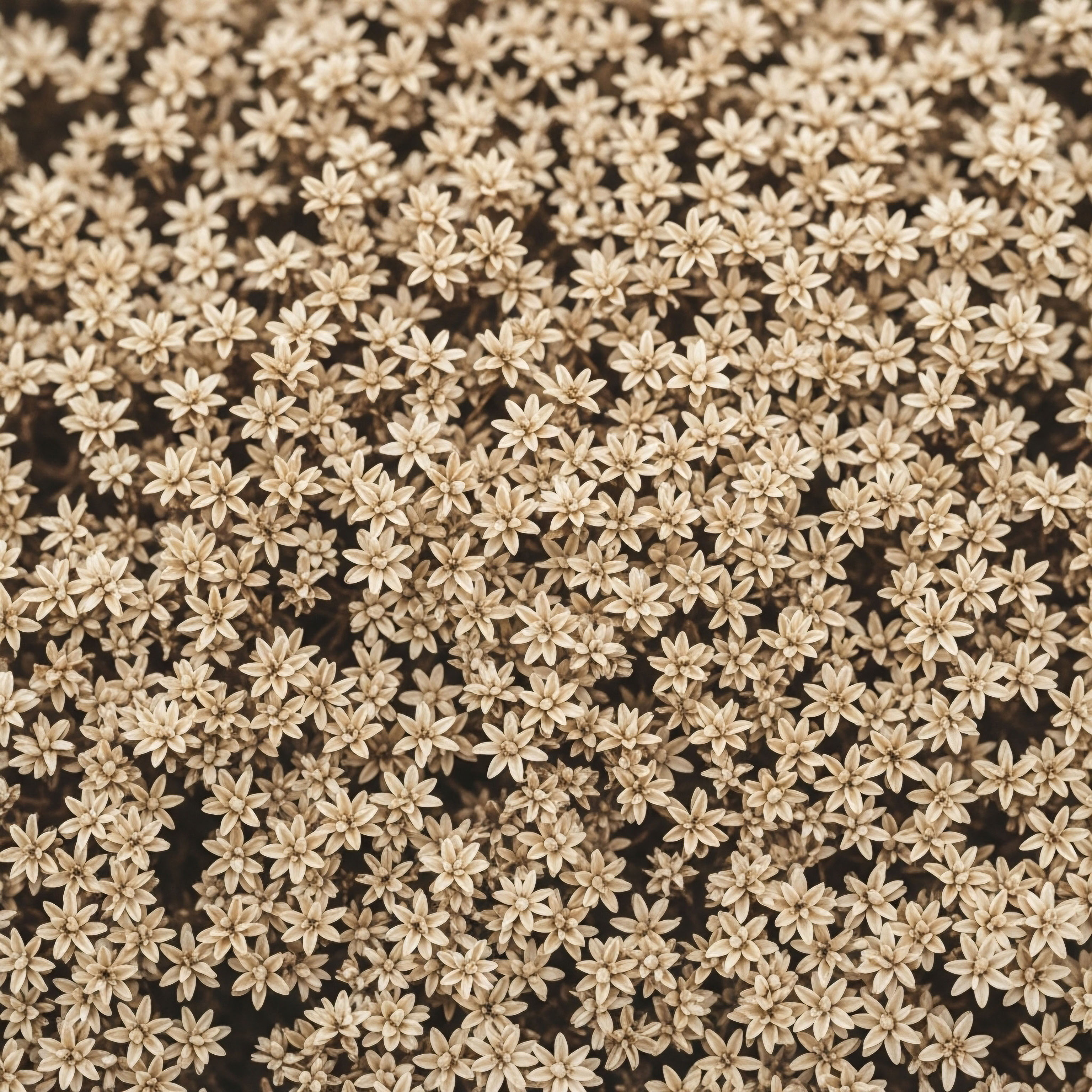

Fundamentals
You feel it ∞ a subtle shift in energy, a change in how your body recovers, a sense that your internal settings have been altered. This experience is a common starting point for a deeper inquiry into your own biology. Your body communicates through these feelings, and understanding the language it speaks is the first step toward reclaiming your vitality.
One of the most powerful internal communication networks is the endocrine system, the intricate web of glands and hormones that governs everything from your metabolism to your mood. At the heart of this system lies growth hormone (GH), a molecule fundamental to cellular repair, body composition, and the feeling of resilience.
The question of whether a simple practice like regular sauna sessions can influence something as profound as your long-term hormonal patterns is a valid and insightful one. The answer begins with understanding how your body responds to intentional, controlled stress.
Heat exposure from a sauna is a form of hormesis, a biological principle where a beneficial effect results from exposure to a low dose of an agent that is otherwise toxic or lethal when given at a higher dose. Think of it as a deliberate, therapeutic stress that prompts a powerful adaptive response.
When you step into a sauna, your body’s core temperature begins to rise. This thermal challenge activates a cascade of physiological processes designed to restore balance. Your heart rate increases, blood flow is redirected to the skin, and you begin to sweat. This is your body’s intelligent, self-regulating mechanism in action.
Simultaneously, this thermal stress sends a signal to your brain, specifically to the hypothalamus. The hypothalamus acts as the command center for your endocrine system, and in response to this heat signal, it initiates a chain of communication that results in the pituitary gland releasing a pulse of growth hormone.
This is a direct, measurable, and potent physiological response. The experience of warmth and relaxation in a sauna is coupled with a profound internal biochemical event. This immediate increase in circulating growth hormone is your body’s adaptive strategy to protect and repair itself in the face of a challenge.
The body’s response to the controlled heat of a sauna initiates a direct signaling cascade, culminating in the pituitary gland’s release of growth hormone.
The implications of this process are significant. Growth hormone is a cornerstone of tissue regeneration. It supports the maintenance of lean muscle mass, aids in the mobilization of fat for energy, and contributes to the health of your bones and connective tissues.
The natural decline of GH production is a well-documented aspect of the aging process, contributing to changes in body composition, reduced recovery capacity, and shifts in overall vitality. By strategically using tools like sauna bathing, you are engaging with your own physiology on a fundamental level.
You are providing a stimulus that encourages your endocrine system to function robustly. This is the foundation of personalized wellness ∞ understanding the biological mechanisms at play and using targeted inputs to guide your body toward a state of optimal function. The journey into hormonal health is one of partnership with your own biology, and the sauna can be a powerful ally in this process.


Intermediate
Understanding that sauna use can trigger a growth hormone release is the first step. The next is to refine the approach, transforming a general wellness practice into a specific protocol designed for a targeted physiological outcome. The key lies in the precise application of frequency, duration, and temperature to manipulate the body’s adaptive response.
The endocrine system, particularly the Hypothalamic-Pituitary-Adrenal (HPA) axis, is a system of feedback loops. Its response is conditioned by the nature of the stimulus it receives. A single, intense session will elicit a different hormonal cascade than chronic, daily exposure.
For growth hormone optimization, the goal is to create a significant, acute stress that prompts a robust secretory pulse, followed by a period of recovery that allows the system to reset. This prevents the blunting of the response that can occur with too-frequent stimulation.

Protocols for Hormonal Influence
Scientific investigation into heat stress has illuminated specific methods for maximizing the growth hormone response. These protocols are designed to push the body just enough to trigger a significant adaptive upregulation. A study published in the Journal of Clinical Endocrinology and Metabolism demonstrated that heat exposure could increase GH levels substantially.
The protocol involved repeated sauna sessions within a single day, which created a powerful stimulus for the pituitary gland. The body’s sensitivity to this stimulus is a critical factor. More frequent sauna use, while beneficial for other reasons like cardiovascular health, appears to attenuate the magnitude of the GH release over time. This suggests that for the specific purpose of maximizing GH, less is more. An infrequent, high-intensity protocol is the most effective strategy.
Strategic, infrequent sauna sessions are designed to maximize the pituitary’s growth hormone response by preventing the adaptive blunting seen with daily exposure.
The timing of sauna use in relation to meals is another important variable. Engaging in sauna sessions in a semi-fasted state, meaning you have not eaten for at least two to three hours prior, can amplify the growth hormone release. This is because lower blood glucose levels create a more favorable environment for GH secretion.
The presence of insulin, which rises after a meal, can suppress the pituitary’s release of growth hormone. By combining the stimulus of heat with a low-insulin state, you are creating a synergistic effect that maximizes the potential for a robust hormonal response.

Comparing Sauna Protocols
The following table outlines two distinct approaches to sauna use, each with different objectives and physiological outcomes. The first protocol is optimized for a maximal, acute growth hormone release, while the second is geared more towards general cardiovascular and recovery benefits.
| Protocol Element | GH Optimization Protocol | General Wellness Protocol |
|---|---|---|
| Frequency | Once per week or less | Two to four sessions per week |
| Structure | Multiple sessions in one day (e.g. 4 x 30 minutes) | Single session per day |
| Duration Per Session | 30 minutes | 20 to 45 minutes |
| Cooling Periods | 5-minute cool-down between sessions | N/A |
| Nutritional Timing | Semi-fasted state (no food 2-3 hours prior) | Hydration is key; timing less critical |
This comparison illustrates the importance of intention in your wellness practices. The same tool can be used in different ways to achieve different results. For an individual seeking to leverage sauna use for its potent effect on growth hormone, adopting the infrequent, high-intensity, multi-session protocol in a fasted state is the most evidence-based approach.
This method respects the body’s need for a strong signal followed by ample time for recovery and adaptation, ensuring that the hormonal response remains robust and does not become desensitized over time.


Academic
A deeper examination of the long-term effects of sauna use on growth hormone secretion reveals a complex interplay between acute hormonal responses and chronic adaptive processes at the cellular level. The significant, transient spikes in serum GH observed after specific sauna protocols are well-documented, with some studies reporting increases of up to 16-fold.
This immediate effect is primarily mediated by the hypothalamus, which, in response to thermal stress, increases the pulsatile release of Growth Hormone-Releasing Hormone (GHRH) and potentially suppresses somatostatin, the primary inhibitor of GH secretion. This shifts the delicate balance of the somatotropic axis, resulting in a large discharge of GH from the anterior pituitary.
However, the central question for long-term physiological alteration is whether these repeated, acute spikes translate into a sustained change in the underlying secretion pattern. The available evidence suggests that the pattern of stimulation is paramount.

The Role of Heat Shock Proteins
At the molecular level, one of the most significant consequences of heat stress is the induction of heat shock proteins (HSPs). These are a family of highly conserved proteins that function as molecular chaperones, assisting in the proper folding of other proteins, preventing protein aggregation, and facilitating the repair or degradation of damaged proteins.
The activation of HSPs is a fundamental survival mechanism that protects cellular integrity during periods of stress. This cellular-level response is intrinsically linked to the endocrine system. The stress signals that trigger the HPA axis and subsequent GH release also initiate the transcription and translation of HSPs.
These proteins, in turn, may play a role in maintaining the health and responsiveness of endocrine tissues, including the pituitary gland. By helping to clear aggregated proteins and repair cellular damage, HSPs could theoretically contribute to the long-term functional capacity of the cells responsible for hormone production. This suggests a mechanism by which regular, controlled heat stress could support the underlying health of the endocrine system, preserving its ability to respond robustly to stimuli.

How Does Sauna Use Affect Long Term GH Secretion?
The long-term effects of sauna use on GH secretion appear to be governed by the principle of adaptive attenuation. Chronic, high-frequency stimulation of most endocrine pathways leads to a downregulation of receptor sensitivity and a blunting of the hormonal response. The somatotropic axis is no exception.
Studies indicate that if the intense sauna protocols that produce a 16-fold increase in GH are repeated daily, the magnitude of this increase diminishes significantly by the end of a week. This is a classic example of physiological adaptation. The system becomes more efficient, no longer needing to mount such a dramatic response to a familiar stressor.
Therefore, a regimen of daily sauna use, while offering other health benefits, is unlikely to produce a sustained elevation of baseline GH levels or maintain the large pulsatile releases seen with initial exposures. Instead, the most effective strategy for altering long-term GH dynamics appears to be the use of infrequent, high-intensity heat stress.
By allowing for a period of 7-10 days between these intense sessions, the system’s sensitivity is preserved, and each session can elicit a maximal response. This approach leverages the body’s acute response mechanisms without triggering the down-regulatory adaptations associated with chronic stimulation.

Summary of Key Research Findings
The following table summarizes key findings from studies investigating the effects of sauna on growth hormone, highlighting the different protocols and their outcomes.
| Study Focus | Protocol | Key Finding | Citation |
|---|---|---|---|
| Acute GH Response | Two 20-minute sessions at 80°C | A two-fold increase in GH levels was observed. | |
| High-Intensity Protocol | Four 30-minute sessions in one day | Up to a 16-fold increase in GH levels was demonstrated. | |
| Frequency and Attenuation | Daily sauna sessions for one week | The initial large increase in GH was reduced to a 2-3 fold increase by day seven. | |
| Fasting and GH Release | Sauna use in a semi-fasted state (2-3 hours post-meal) | Lower blood glucose levels encourage greater GH release during heat exposure. |
The academic perspective on sauna use and growth hormone moves beyond simple cause and effect. It reveals a sophisticated relationship where the pattern, intensity, and frequency of the stimulus are the critical determinants of the long-term outcome.
The goal is not to chronically elevate GH, but to strategically induce potent, pulsatile releases that support tissue repair and metabolic health, while preserving the sensitivity of the underlying endocrine machinery. This is achieved through infrequent, intense application of heat stress, a method that respects the body’s intricate systems of adaptation and feedback.

References
- Leppäluoto, J. et al. “Endocrine effects of repeated sauna bathing.” Acta physiologica Scandinavica 128.3 (1986) ∞ 467-470.
- Hannuksela, Minna L. and Samer Ellahham. “Benefits and risks of sauna bathing.” The American journal of medicine 110.2 (2001) ∞ 118-126.
- Kukkonen-Harjula, K. et al. “Haemodynamic and hormonal responses to heat exposure in a sauna.” European journal of applied physiology and occupational physiology 58.5 (1989) ∞ 543-550.
- Scoon, G. S. et al. “Effect of post-exercise sauna bathing on the endurance performance of competitive male runners.” Journal of Science and Medicine in Sport 10.4 (2007) ∞ 259-262.
- Veldhuis, Johannes D. et al. “Twenty-four-hour rhythms in plasma concentration of growth hormone in men and women ∞ a statistical-mechanical analysis.” Journal of Clinical Endocrinology & Metabolism 62.1 (1986) ∞ 71-82.

Reflection
You have now explored the intricate biological conversation between intentional heat exposure and your body’s hormonal systems. This knowledge provides a framework, a map of the physiological territory. The true journey, however, is deeply personal.
It involves listening to your own body’s unique responses, observing the subtle shifts in your energy and recovery, and integrating this practice in a way that aligns with your individual constitution and goals.
The information presented here is a powerful tool, yet the most profound insights will come from the direct experience of applying this knowledge and paying close attention to the feedback your own system provides. What does your body tell you after a session? How does your sleep change?
What patterns do you notice over time? This path of self-discovery, guided by both scientific understanding and personal observation, is the essence of reclaiming your vitality. It is a proactive partnership with your own biology, a continuous process of learning, adapting, and optimizing your own unique system for a lifetime of function and well-being.

Glossary

endocrine system

growth hormone

heat exposure

hormesis

sauna bathing

personalized wellness

growth hormone release

sauna use

lower blood glucose levels

heat shock proteins




